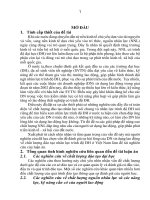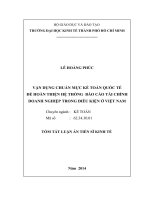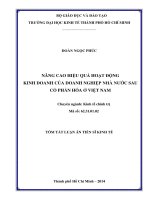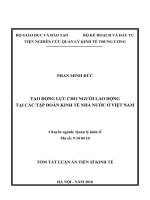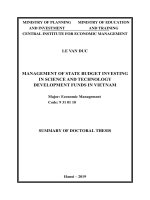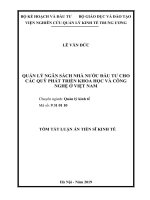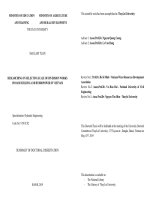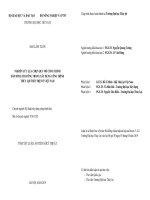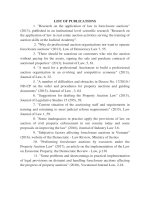Nghiên cứu mức độ ảnh hưởng của các yếu tố rủi ro đến chi phí đầu tư xây dựng công trình thủy điện vừa và nhỏ ở việt nam tt tiếng anh
Bạn đang xem bản rút gọn của tài liệu. Xem và tải ngay bản đầy đủ của tài liệu tại đây (645.2 KB, 27 trang )
MINISTRY OF EDUCATION AND
TRAINING
MINISTRY OF AGRICULTURE
AND RURAL DEVELOPMENT
THUYLOI UNIVERSITY
DO VAN CHINH
RESEARCHING THE IMPACT LEVEL OF RISK FACTORS
ON CONSTRUCTION INVESTMENT COSTS OF MEDIUM
AND SMALL HYDROPOWER PROJECTS IN VIETNAM
Speciality: Construction Management
Speciality code: 9 58 03 02
SUMMARY OF ENGINEERING PHD THESIS
HANOI, 2019
The thesis is completed at: Thuyloi University
Advisor 1: Associate Prof. Dr. Nguyen Ba Uan
Advisor 2: Prof. Dr. Vu Thanh Te
Reviewer 1:
Reviewer 2:
Reviewer 3:
The thesis will be defended in front of Examination Committee at Room 5 - K1
Thuyloi University at…. hours…. date…. month…. year….
The thesis can be found at the library:
- Vietnam National library
- The library of Thuyloi University
INTRODUCTION
1. Research significances
In Vietnam, the significancy of risk assessment of construction projects in
general and in the hydropower sector itself has not been seriously concerned,
leading to unforeseen risks during the project implementation process. Thus,
the goals of the project would be affected. Given the context that almost the
small and medium hydropower (SMH) projects are built in remote and
mountainous areas, rugged terrain with the occurrence of landslides in the flood
season, these projects will face many difficulties and their risks are more
present and unpredictable.
The determination, identification and assessment of the impact of risk factors
on the project objectives (time, cost, quality) are main sources supporting
investors in making a sound decision on the project investment . It also helps
contractors, state management units and other stakeholders make proactively
assessments and solutions in mitigating risks, reducing cost losses for the
government.
Therefore, the topic "Researching the level of impacts of risk factors on
Construction investment (CI) costs of medium and small hydropower projects
in Vietnam" is necessary, scientific and practical.
2. Research Objectives
The research aims to identify risk factors, classify and assess the impact of
these risk factors on the investment costs of the SMH (SMH) projects, in
Vietnam. Consequently, the research proposes a number of solutions to
minimising risks importantly affecting the SMH project investment costs.
3. Research subject and scope
3.1. Research subject
1
The subject of the study is the risk factors in investment and construction of the
SMH projects in Vietnam focusing on the quantitative study of the impact of
risk factors on construction investment (CI) costs.
3.2. Research scope
(i) Risk factors in the pre-construction and construction stage. (ii) Researching
to identify, classify, rank and assess the impact degree of risk factors on CI
costs (total investment approved) of the SMH projects in Vietnam. (iii)
Analysing in research by using primary and secondary data collected from 2005
to present and the strategy for developing SMH in Vietnam to 2020 and the
vision to 2030.
4. Research Content
(i) Identifying scientific basis to determine the list of risk factors which have
effect on CI costs of the SMH projects in Vietnam. (ii) Classifying and
verifying the reliability of the scale of risk factors affecting the investment costs
of the SMH projects in Vietnam. (iii) Assessing the impact level of risk factors,
pointing out the risk factors that significantly influence CI costs in the SMH
projects. (iv) Partitioning of risk levels and suggesting mitigation measures of
risks that considerably affecting the investment costs of the SMH projects in
Vietnam.
5. Research methods
The following methods used in the study include: Inheritance approach;
comparison and synthesis; qualitative research; quantitative research; expert
methods; importance weight of risk criteria.
6. Scientific and practical significance of the research
6.1. The scientific meaning
The thesis provides a scientific basis for determining the list and classification
of risk factors affecting the investment costs of the SMH projects in Vietnam.
2
(ii) The thesis presentes the method and results of assessing the influence of
each risk aspect on cost, showing the risk factors of investment cost of the SMH
projects in Vietnam as a scientific basis to propose some solutions to mitigate
the effect of risks on CI costs.
6.2. The practical meaning
(i) The research results are considerred as an important basis for the
government institutions, clients and related entities to consult, apply, advise
proactive solutions to investment of SMH projects in Vietnam. (ii) Research
result also is significant for the study of assessing and quantifying the damage
of some risks to the project objectives. Risks are allocated to stakeholders in the
investing process of SMH projects in Vietnam.
7. Thesis structure
In addition to the introduction and conclusion, conten of the thesis includes:
Chapter 1: The overview of research issues related to the study
Chapter 2: Theoretical framework and research methods
Chapter 3: The evaluation of the impact level of risk factors to the cost of CI in SMH
projects in Vietnam
Chapter 4: Inspecting of research results and proposing solutions to reduce risk
influence affecting the cost of investment in building SMH projects in Vietnam
CHAPTER 1: THE OVERVIEW OF RESEARCH ISSUES RELATED
TO THE STUDY
1.1. The overview of the SMH projects in Vietnam
1.1.1. The definition of SMH
Globally: Small hydropower is defined as the hydropower with its capacity
ranging from 0.1 MW to 10 MW, while medium hydropower is with its
capacity from 10 MW to 100 MW.
3
In Vietnam: Small hydropower is with its capacity from 1 to 30 MW, SMH is
the hydropower with a capacity of 50 MW or less.
1.1.2. The role of SMH
Hydropower in general and SMH itself plays enormous roles in the electricity
industry as ensuring electricity supply for the whole country, promoting
economic development, preserving ecosystems, accumulating and discharging
power
according
to
the
electricity
system
requirement,
mitigating
environmental pollution, solving multi-objective problems and improving
social equity.
1.1.3. Characteristics of the SMH projects in Vietnam
Not only hydropower projects but SMH are mostly built in mountainous areas,
where complex terrain and geology exit.
The catchment area of the SMH projects is relatively large depending on the
size and capacity of the plant.
CI capital for the SMH projects is often large and long payback period.
The SMH projects have a moderate construction period, but the operation
period is relatively long.
The benefits of hydropower projects depend heavily on nature because
hydropower projects relies on source of water.
Hydropower projects have a profound effect on the environment and society.
1.1.4. The potential of SMH in Vietnam
As stated by theoretical calculations, the hydropower potential in our country is
considerable with a total potential capacity about 35,000 MW and electricity
output is about 300 billion kWh/year. However, in terms of feasibility, about
26,000 MW can be exploited with electricity volume of more than 100 billion
kWh / year, particularly SMH accounts for 15-20 billion kWh / year.
4
1.1.5. Construction investment costs of the SMH projects in Vietnam
Depending on each stage of the CI process, the CI cost is indicated by the total
investment cost at the pre-construction stage; construction cost estimates at the
construction stage; the value of payment and settlement of investment capital
upon the completion of construction and post-construction stage. In the thesis,
the author studies the risks in the stages of pre-construction and construction
that increase the initially approved investment value of the project.
The investment unit cost for construction of hydropower plants is the necessary
unit expense for the new construction projects, calculated on a basis of a design
capacity unit of the project. The investment unit cost is the basis for
determining the total CI, determination and management of CI costs of
hydropower projects at the pre-construction stage.
In the world: the average investment unit cost for SMH ranges from 1300-8000
USD / Kw; large hydropower ranges from 1050 - 7650 USD / Kw
In Vietnam: the investment unit cost of hydropower plants for 1 Kw of the
installed capacity of small hydropower averages VND 25-30 million; Large
hydropower fluctuates 20-25 million VND.
1.2. The overview of studies on risks in construction investment
1.2.1. Risk definition
According to traditionalism, the risk is damage, loss, danger or factors related
to danger, difficulty or uncertainty that can happen to people. Some authors
who agree with traditionalism may include: Allan Willett, Ricardo Antunes and
Vicente Gonzalez, Jorge Cunhaa & Paula Ferreiraa.
According to modernism, the risk is uncertainty that can be measured, both
positive and negative. Risks can bring losses to people but can also bring
benefits and opportunities. The same point of view can be mentioned by the
authors: Frank Knight, Irving Preffer, Ratna S. Shrestha, Marcello N. Cabral Da
Costa.
5
1.2.2. Research on risks in construction investment (CI)
Research on risks in CI are very diverse in all areas such as Transport (Trinh
Thuy Anh, 2006), Petroleum (Le Dang Thuc (2017), Rural Agriculture (Tran
Quang Phu, 2016), etc. Some authors mentioned above have identified and
classified risk groups, determined the impact level of risk factors, introduced
measures and solutions to mitigate risks in CI in general.
1.2.3. Research on risks of construction investment costs
Studies on risks of construction projects investment cost have recognised and
categorised risk groups affecting the project objectives, some studies have
expressed the risk factors that have strong and weak impacts, risk mitigation
solutions as well as cost and time control models have been developed.
1.2.4. Research on risks in hydropower investment construction
Research on risks in hydropower investment construction in the world shows
that the authors have identified and classified the risk factors affecting the
construction project, specifying the risk groups that have major effects on the
project objectives and the research have also provided effective risk
management solutions for participants to make better decisions.
1.3. Research gap
Studies around the world focus primarily on risk management in hydropower
projects. In Vietnam, there are a few risk studies in the hydropower sector
concentrating mainly in the field of investment construction in general (oil and
gas, transportation, civil ...) and some areas such as banking and insurance.
Only several papers studied on risks of project schedule delays and of
construction contract in hydropower projects.
1.4. Research objectives and orientation
The thesis focuses on clarifying the following issues: (i) Developing a scientific
basis to identify and classified risk factors; (ii) Building a scale of risk factors
6
influencing the investment costs of the SMH projects in Vietnam, verifying the
scale suitability and the research questionnaire; (iii) Categorising the impact of
risk factors on investment costs of SMH; (iv) Assessing risk factors on the
investment costs of SMH, and proposing mitigation measures for major risks.
1.5. Conclusion
Risk in the CI of SMH project is a new issue in Vietnam. There has not been
any research done in the field of hydropower in general, SMH itself including
identification, classification and evaluation of the scope of influence and
assessing risks to CI costs. There are numerous risks, but we may not control
and prevent all risks. Thus, it is necessary to identify, classify, evaluate and
assess risks to know the frequency of risks and the level of risk impact. As a
result, appropriated risk mitigation solutions would be made.
CHAPTER 2: THEORERICAL FRAMEWORK AND RESEARCH METHOD
2.1. Theoretical framework for determining the typology of risk factors
affecting CI costs of the SMH projects in Vietnam
2.1.1. Preliminary classification of risk factors in studied the SMH projects
Depending on the purpose of the risk assessment, the author has categorised
risks according to different ways. The researcher synthesizes and preliminary
classify the risk groups as follows:
Table 2.2: Preliminary risk classification in the SMH projects
No.
Risk factors
No.
Risk factors
A
Political and policy factors
11
1
Political conflicts
12
2
Frequent change of legal documents
E
3
Corruption, collusion of parties in project
implementation
13
B
Natural elements
14
Contractor capacity
Collaboration between clients and
stakeholders
Factors in the process of project
implementation
Risks in compensation, support and
resettlement
Risks in design and cost estimation
4
The extreme climate
15
Risks in construction stage
7
5
16
C
Irresistible circumstance
Geological and hydrological risks at
complicated construction site
Economic and financial risk factors
18
Risks in contract changes
Delay in the supply of materials and
equipment
Risk in payment
7
Inflation risk
19
Risk in low technology
8
Interest rate risk
F
Project environmental factors
9
Exchange rate risk
20
Air pollution, noise, water, and waste
D
Capacity of stakeholders
21
Impact on flora, fauna, aquatic life
10
Client capacity
22
Sliding, erosion, river sedimentation
6
17
2.1.2. Determining risks affecting the investment costs of the SMH projects
The author uses risk-based identification method through completed projects,
under-construction projects and projects that have been removed in the past to
identify, supplement and remove the risks influencing the investment costs of
the SMH projects in Vietnam. The author has identified 29 influential risk
factors according to the following table.
Table 2.7: Risk factors affecting CI costs of the SMH projects in Vietnam
No.
A
1
2
3
4
5
B
6
7
8
C
9
10
11
12
D
Influential risk factors
Group of policy factors and state management
Risks from the management decentralization of the SMH projects
Weakness in decision-making process
Legal documents system changes frequently
Inappropriate local hydropower development policy
Corruption, collusion of parties in project implementation
Group of natural elements
The extreme climate
Irresistible circumstance (natural disasters, enemy-inflicted devastation)
Geological and hydrological risks at complicated construction site
Group of economic and financial risk factors
Inflation
Interest rate
Exchange rate
Economic growth rate
Group of capacity elements of stakeholders
8
13
14
15
E
16
17
18
19
20
21
22
23
24
25
26
F
27
28
29
Client capacity
Contractor capacity
Collaboration between clients and stakeholders
Group of factors in the process of project implementation
Risks in compensation, support and resettlement
Uncompetitive bidding
Risks in the topographical and geological survey process
Risks in design and cost estimation
Risks in construction stage
Risks in the ability to attract financial capital
Risks in contract changes
Disputes in the acceptance of the settlement
Risk in low technology
Delay in the supply of materials and equipment
Risk of construction quality
Group of project environmental factors
Air pollution, noise, water, and waste
Impact on flora, fauna, aquatic life
Sliding, erosion, river sedimentation
2.2. Research methodology
2.2.1. Research process
In order to achieve the research objectives and answer the research questions,
the author uses a combination of theory and practice. Besides that, a process
approach is also applied to propose a six-step process from the research
overview to determine risks; classify and supplement preliminary research
surveys; survey formal research; doing quantitative research of risk factors;
assessing risks and suggesting risk reduction solutions.
2.2.2. Research design
- Research scale: Selecting Likert scale with 5 rating levels to survey the
frequency of occurrence and 5 rating levels to assess the effect of risks on CI
costs of the SMH projects in Vietnam.
- Respondents: construction experts, client/project management team,
associated departments and agencies, design consulting team, construction
9
contractors, construction supervision, material suppliers and other related
parties in the field of small and medium hydroelectricity.
- Sampling method: Convenience sampling
- Sample size: Choosing the number of samples according to Bollen's empirical
formula: At least 5 observations per variable (ratio 5: 1).
- Data collection method: Interviews and questionnaires
2.2.3. Methods of analysis and risk assessment in the project
Currently, a number of risk analysis and assessment tools are often used such as
decision tree analysis method, sensitivity analysis, method of applying
simulation theory, probability analysis, importance weight of risk criteria. Each
method has different advantages and disadvantages which are summarized by
the author in Table 2.11
Table 2.11: The comparison between advantages and disadvantages of each
analytical method
No.
Method
Advantages
- Simple diagram,
understanding.
1
Decision
tree analysis
- Provides results
probability conditions
Disadvantages
easy
in
2
estimated
- Requires more time and
cost depending on the
- Helpful in making size and flexibility of
decisions
based
on each case
continuous events
- Calculable and explainable
Sensitivity
analysis
- Requires
probability
- There is no probability
of the final result
- Probability estimate is not
- Limits in the interaction
required
of variables
- Focuses on the small
- Difficulties in decision
number of variables
chains
10
3
4
5
Probability
analysis
Monte
Carlo
simulation
Importance
weight of
risk criteria
- Provides results
probability conditions
in - Difficult to
historical data
collect
- Processes information from - Based on subjective
various sources
judgment
- Provides results
probability conditions
- Requires much cost
in and time
- Must have probabilities
- Considers different sources of input variables
of risk
- Limits on solving
- Can model decision chains interactions
between
variables
- Evaluates the level of
influence through rating the - Probability based on
risk level
subjective judgment of
Provide
results
in experts
probability conditions
Based on analysis of advantages and disadvantages of methods; objectives and
scope of research; content and research results are expected to be achieved; data
collected for analysis, the author selected Risk importance weight criteria to
analyse and assess the impact of risk factors through ranking the importance of
each risk factor and risk classification.
2.2.4. The selection of analytical tools and the inspection of research data
- The selection of analytical tools: In the thesis, the author selected SPSS
software to analyse and process data because it is particularly popular software,
straightforward to use and fully demonstrate the results for research
- The verification of research data: Scale reliability testing and EFA
discovery factor analysis are applied to eliminate garbage variables before
being included in the analysis.
2.3. Conclusion of chapter 2
11
The researcher provides a scientific basis to identify and classify risk factors.
Risk factors in the process of comprehending SMH construction projects
including both under construction and completed projects in Vietnam are
additionally identified and eliminated. The method used to rank the impact
level of risk factors and analyse the influence of each factor group on CI costs
of these projects in Vietnam is also selected.
CHAPTER 3: THE EVALUATION OF THE IMPACT LEVEL OF RISK
FACTORS TO THE COST OF CI IN MEDIUM AND SMALL
HYDROPOWER PROJECTS IN VIETNAM
3.1. Preliminary study survey
3.1.1. Encoding scale
- The group of policy factors and state management includes 5 elements coded
scale from CS & QL1 to CS & QL5
- Natural elements consists of 3 elements are encoded scale from TN1 to TN3
- The group of economic and financial factors includes 4 elements that are
encoded from KT-TC1 to KT-TC4
- The group of factors related to the capacity of stakeholders consists of 3
elements encoded scale from NLCB1 to NLCB3
- The group of factors in the process of implementing the project includes 11
elements that are encoded scale from TKDA1 to TKDA11
- The group of environmental risk factors of the project consists of 3 elements
encoded scale from MT1 to MT3
3.1.2. Analysis of preliminary research results
The author selected 15 experienced experts in the field of hydropower currently
being in charge of many important positions and roles in businesses /
companies Client/Project Management Board, Design Consultant, Construction
Supervision, Contractors, Departments, ... to conduct interviews.
12
By carrying out the test of the scale through the reliable coefficient method of
Cronbach’s Alpha factors, the researcher has synthesized and identified 24 risk
factors included in the official survey.
3.2. Official survey
3.2.1. Data description
- Research samples: The researcher selected samples from Bollen point of
view, 1989: minimum 5 samples for 1 research variable. Thus, the number of
required samples in the survey is 24 x 5 = 120 samples.
- The period of survey: from July 2018 to October 2018
- Sample results are included in analytical research: 150 samples
3.2.2. Scale reliability test
- Cronbach’s Alpha analysis results
Table 3.10: Analysis results of Cronbach’s Alpha influence scale
Scale
Cronbach’s
Alpha inspection
coefficient
Cronbach’s Alpha
inspection coefficient
(If removing variables)
Group of policy factors and
state management
0.809
0.863
Group of natural elements
0.787
0.787
Group of economic and
financial risk factors
0.872
0.872
Group of capacity elements of
stakeholders
0.749
0.749
Group of factors in the process
of project implementation
0.805
0.878
Group of project environmental
factors
0.855
0.855
13
Table 3.11: Analysis results of Cronbach’s Alpha frequency of occurrence
Scale
Cronbach’s
Alpha inspection
coefficient
Cronbach’s Alpha
inspection coefficient (
If removing variables)
Group of policy factors and
state management
0.699
0.728
Group of natural elements
0.698
0.698
Group of economic and
financial risk factors
0.744
0.744
Group of capacity elements of
stakeholders
0.907
0.907
Group of factors in the process
of project implementation
0.680
0.71
Group of project environmental
factors
0.832
0.832
- KMO test results
The KMO coefficient of the two scales including the impact and the frequency
are 0.842 and 0.769 respectively, matching the condition of 0.5
show that exploratory factor analysis is appropriate for actual data and observed
variables are linearly correlated with representative factors.
- Rotation matrix elements: the rotation matrix is used to determine the
factors that obtain the results of each scale influence and the frequency of
convergence on groups and the loading factor (Factor loading)> 0.5.
After testing the reliability of the scale and analysing of the exploratory EFA
factor, two factors are removed (CS & QL5 - collusion, corruption of
participants during project implementation and the element TKDA 6 - ability to
attract financial capital). Thus, there are only 22 risk factors affecting the CI
costs of the SMH projects in Vietnam.
14
3.3. Ranking of risk factors
In order to rank the risk factors in the thesis, the importance weight of risk
criteria is used to indicate the importance of each risk factor based on the
assessment of the risk impact and probability. The importance weight of risk
criteria is determined by the following formula:
R = ∑ Xij*Wij
(2-2)
R: The importance weight value of each risk factors
Xij: Probability occurs at the same time (i) the influence degree of each risk
factor (j); with i = 1 ÷ 5 and j = 1 ÷ 5
Wij: Combined weight between frequency (i) and the degree of influence (j)
Results of determining the importance weight and ranking of risk factors are
shown in Table 3.20.
Table 3.20: The impact level of risk factors ranking
Risk factors
The extreme climate
Complicated topography and geology
Irresistible circumstance (natural disasters,
enemy-inflicted devastation)
Risks in construction stage
Client capacity
Risks in compensation, support and resettlement
Inflation
Sliding, erosion, river sedimentation
Impact on flora, fauna, aquatic life
Contractor capacity
Air pollution, noise, water, and waste
Uncompetitive bidding
Collaboration between clients and stakeholders
15
The importance
weight of risk
criteria
1253,3
1240,8
Ranking
1
2
1225,1
3
1159,1
1158,7
1150
1127,2
1122,1
1082,7
1079,8
1044,2
4
5
6
7
8
9
10
11
1036
1028,4
12
13
Interest rate
Risks in design and cost estimation
Economic growth rate
Risk in technical issues and low technology
1016,9
1016
999,9
999,6
14
15
16
17
Exchange rate
969,1
18
Weakness in decision-making process
902,07
19
Risks from the decentralization of management
of the SMH projects
868,46
20
Legal documents system changes frequently
858,7
21
Inappropriate local hydropower development
policy
834,5
22
3.4. Risk assessment
Table 3.21: Risk matrix
5
10
15
20
25
Almost certain
4
8
12
16
20
Likely
3
6
9
12
15
Possible
2
4
6
8
10
Unlikely
1
2
3
4
5
Rare
Moderate
Significant
Severe
Insignificant
Minor
Table 3.22: The classification of risk levels and mitigation planning
No.
Level
Oscillating point
1
Low risk
1 < point < 6
Little concern, providing situation
solutions
2
Medium risk
6 < point < 12
Concern, offering mitigation solutions
for a number of considered factors
3
High risk
12 < point < 20
High concern, offering solutions to
minimise and control
4
Very high risk
20 < point < 25
Significantly high concern, making
plans and measures to control risks
16
Risk mitigation planning
Result of risk assessment: Three risk factors of nature for highland areas are
neededd to be highly concerned. There are 19 risk factors placed at medium
risk level, some mitigation measures should be given to considered risk factors.
3.5. Assessing the impact of risk factors on the scale of influence and the
frequency of occurrence
Based on analysis and evaluation of the effect of each observed variable on
each influence and requency scale, all coefficients are greater than 0, which
proves the possitive effects. In orther world, any positive impact on any
observed variable can increase the value of each factor.
3.6. Assessing the influence of groups of factors and risk factors on CI costs
of SMH in Vietnam
From the ranking and risk level results, the author analyses and evaluates the
effect of each group of risk factors on CI costs of the SMH projects in Vietnam.
3.7. Conclusion of chapter 3
The author has identified 22 risk factors and ranking the level of influence of
risk factors, assessing risks as well as pointing out the risks that greatly affect
CI costs of the SMH projects in Vietnam by determining the importance weight
of risk criteria based on expert judgment on the scale and frequency of
impressions.
17
CHAPTER 4: VERIFICATION OF RESEARCH RESULTS AND PROPOSING
SOLUTIONS TO REDUCE RISK INFLUENCE AFFECTING THE COST OF
INVESTMENT IN BUILDING SMH PROJECTS IN VIETNAM
4.1. Verification of research results
The author compared the results of theoretical research with the causes in fact
that increase the CI costs through 3 on-going projects including: Nam Tha 3
hydropower project, Lao Cai (14 MW); Huong Son and Ha Tinh hydropower
projects (33 MW); Nam Xay Luong and Lao Cai hydropower projects (13
MW). There are similarities of strong influencing factors which increase CI
costs to projects such as: climate change and floods, delays in construction
progress, price fluctuations; complicated geology, risks in compensation,
support and resettlement besides other causes.
4.2. Solutions to mitigate risks of SMH investment in Vietnam
4.2.1. General solution to minimize risks of CI costs of the SMH projects
The author introduces a process of investment in the construction of the SMH
projects, which will provide corresponding solutions in each process. The
process of investment in SMH construction consists of 9 steps. In step by step,
solutions for each relevant object are provided and direct responsibility to
minimize risks in each project implementation process is also taken.
Figure 4.1: Investment process for construction of SMH plants
18
4.4.2. Risk mitigation solutions for some risk factors that greatly affect the
investment costs of the SMH projects in Vietnam
4.4.2.1. Solutions for the extreme climate-related risks
Some risk mitigations include:
4.2.2.2. Solutions for irresistible circumstances-related risks
Solutions for natural disaster prevention and mitigation
19
4.2.2.3. Solutions for complicated topography and geology-related risks
4.2.2.4. Solutions compensation, support and resettlement-related risks
* For state management institution
- Completing the system of documents on compensation, support and
resettlement.
- Promulgating synchronous policies at the national migration and resettlement
for hydropower projects.
- The state should pay more attention and invest in land management, set up
cadastral files and grant full land certificates.
- Inspecting and examining relevant parties in the implementation of
compensation, support and resettlement to promptly detect and handle frauds
and profiteering.
* For the locality
- Consulting associated parties to investigate and collect data accurately on the
land area which will be supported, compensated and resettled.
- Spreading and disseminating current policies and regulations on
compensation, support and resettlement to people in the project area.
20
- Ensuring security and safety in compensation, site clearance, support,
migration and resettlement.
* For project clients
- Working closely with local authorities; improving the effectiveness of
assessment and preparation of compensation and resettlement plans for
projects.
- Publicising unit prices and detailed compensation measurements for each
property to affected individual;
- The construction of resettlement areas must ensure stability, consistent with
production activities and appropriate with local culture;
- Researching and issuing benefit sharing policies between clients, localities
and people affected by construction projects;
4.2.2.5. Solutions for client capacity-related risks
- Strictly managing CI of hydropower projects: complying with the provisions
of law on investment, construction, water resources and environment.
- Selecting competent clients including capacity, experience and finance
resources to implement the project.
- Clients have plans and measures to select good and experienced contractors
regarding survey, design, construction and construction in the field of
hydropower construction.
- Planning and identifying potential risks that may occur when deploying the
construction of the project so that there will be a special solution to control the
risks during the construction process
21
4.2.2.6. Solutions for construction stage-related risks
4.2.2.7. Solutions for inflation-related risks
- Reinforcing the management of the state budget, focusing on preventing loss
of revenue, implementing thoroughly savings and cutting expenses that are not
really necessary.
- Strengthening the capacity of forecasting apparatus to accurately forecast
price fluctuations in the world market, especially prices of strategic items such
as petrol, oil, food ... to keep up domestic price adjustment.
22
- Establishing the national cost management organisation for basic goods with
the responsibility for controlling and administering the price of basic goods
under the direction of the government.
- The administration of interest rates must be flexible, while ensuring inflation
control and stimulating economic growth.
4.3. Conclusion
The author has re-tested the causes of increasing CI costs in the SMH projects
including both completed and on-going projects. It has been found that the
results are quite similar. Based on the research results, the researcher has
provided some mitigation solutions for risks that greatly affect the investment
costs of the SMH projects in Vietnam.
23
